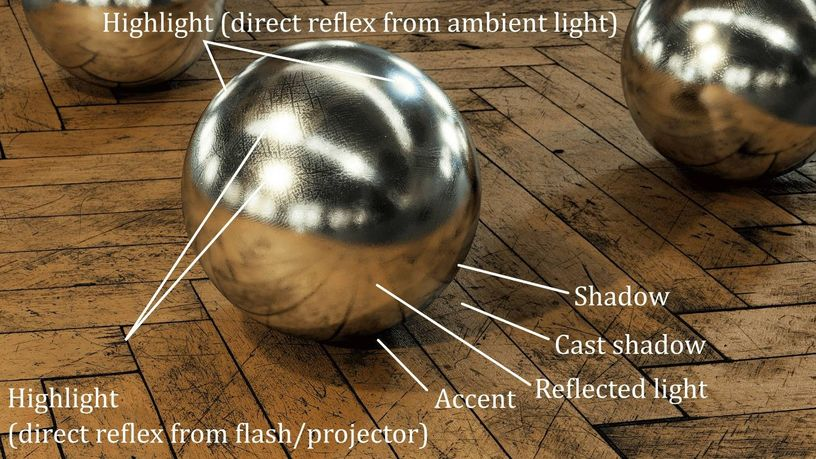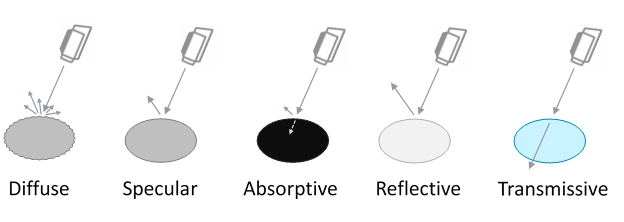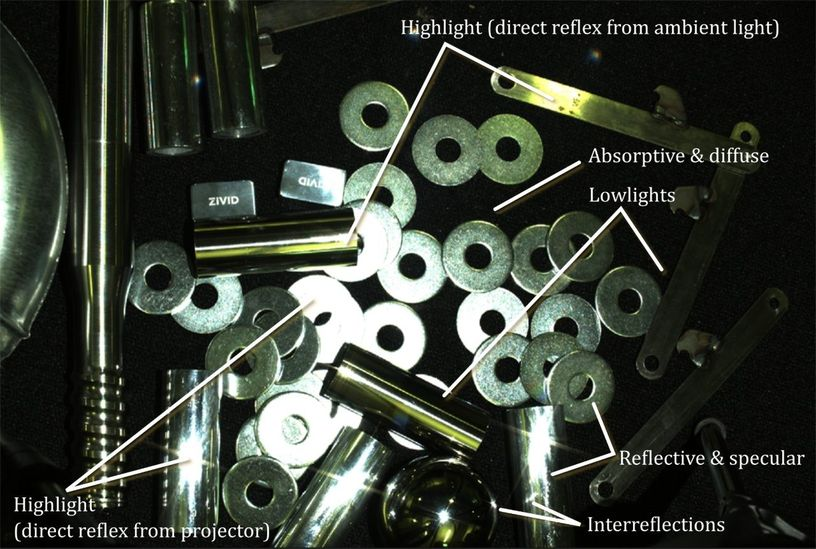Optical Properties of Materials
Introduction
We can see our surroundings in all their colors and vividness due to the interplay between photons and matter. As light travels through space, the photons interact with particles in their path, which can cause the photon to change its course or convert to another form of energy. How light interacts with objects depends on the chemical composition of the material and can be described by three properties: specularity, absorptivity, and transmissivity. The magnitude of these properties varies within a material as a function of the wavelength of light.
Specularity
Mirrors, chrome, and window glass are examples of materials with high specularity. These materials have in common that their surface texture is very smooth and fine-textured and are often described, somewhat imprecise, as reflective. Rubber, wood, leaves, and chalk are materials with low specularity. These objects have in common that though they are easy to see, they do not cast a reflection. The material surface has a very diffuse texture, which causes incident light to scatter almost uniformly in all directions. Therefore, it would not be possible to see a reflection in, e.g., a mirror made of chalk.
Transmissivity
Transmissivity describes a material’s ability to pass light through. Window glass, clear water, certain plastics and epoxies are examples of materials with high transmissivity. Even though the light may change direction, be diffracted or refracted, it passes through the material rather than being bounced back where it came from. A material with low transmissivity will therefore reflect light instead, and you will not be able to see through it.
Absorptivity
Absorptivity describes a material’s ability to absorb an incident photon and convert it to another form of energy, such as heat or electricity. Black objects like rubber tires, coal, TV, and smartphone displays have high absorptivity of visible light and typically get relatively hot when left out in the sun. Objects with low absorptivity will either reflect the light or pass it through, depending on the level of transmissivity, as mentioned above. Therefore, materials with low absorptivity are window glass and still water, but white paper, wood, aluminum, and white chalk are also. In addition, some materials (colored objects) are partially absorptive.
Red and green apples are highly absorptive of all wavelengths of visible light, except red (700 nm) and green (530 nm), respectively. For this reason, some structured light scanners, like those using a red laser source, can get very good results on red objects. At the same time, they would get very poor results on blue objects, even though the objects have the same shapes.
Typical effects of specularity and reflectivity
When dealing with materials that are highly specular and reflective, there are a handful of optical effects that take place.
Highlights from direct reflection either caused by ambient or an intended light source.
Interreflections between objects:
Reflections from surrounding objects onto the object.
Reflections from the object onto surrounding objects.
Low-lights caused by light being scattered off angular planes.
The image below shows an example of how some of these effects may take place.

Summary
The image below depicts an overview of the various optical properties of materials described above. The two figures to the left illustrate different levels of specularity, while figures three and four from the left illustrate different absorptivity levels. The rightmost figure illustrates transmissivity.

The sum of these optical properties of a material determines how easy or difficult it is to see it and thus how applicable it is for a 3D scanner. Objects and scenes that have low specularity, absorptivity, and transmissivity are preferable for most optical instruments. Increasing the degree of any of the three properties is the fundamental challenge. Many 3D scanners today are struggling to produce satisfactory results on what we typically refer to as transparent and shiny objects. The figure below shows an example of a challenging scene containing both reflective, specular, and absorptive materials.
